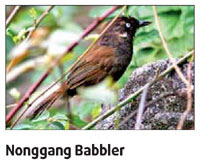New Chinese Bird Species Discovered
Posted by: Loren Coleman on June 18th, 2008
The Chinese news source Xinhua is announcing on Thursday, June 19, 2008, the confirmed discovery of a new species of bird, the Nonggang babbler or Stachyris nonggangensis.

It has a white crescent-shaped patch behind the ear and some grayish-brown spots on the white throat. Apart from that, it’s dark brown all over.
It prefers to walk, flying only when frightened. It often feeds on worms and insects in the gaps between rocks.
Meet the new species of bird discovered by Chinese ornithologists on a small patch of limestone rainforest on the Sino-Vietnamese border.
No ornithologist had sighted the myna-sized bird before probably because of its plain looks and skulking habit.
Zhou Fang, of the College of Animal Sciences and Technology, and Jiang Aiwu, one of his graduate students, first saw it during a survey at the end of 2004. It took almost four years of studies and fieldwork to confirm it’s a new species. Zhou’s college is affiliated to Guangxi University in Nanning, capital of the Guangxi Zhuang autonomous region.
“After seeing the birds a few times during our survey, Professor Zhou told me it’s probably a new species,” says Jiang.
“I have been studying birds in the region since the 1970s,” the 59-year-old ornithologist says. “But I had never seen it before.”
Zhou and Jiang caught two of birds on January 21, 2006, to conduct a thorough study.
As the bird is seen only in and around the Nonggang Natural Reserve of Guangxi, only 18 km southeast of the Vietnamese border, it has been named the Nonggang Babbler (Stachyris nonggangensis).
The global scientific community has confirmed their finding, and the Auk, the world’s leading journal on ornithology, published their study in its 125th issue recently.
This is the second time Chinese scientists have found a new species of bird in the country. The first was in the 1930s. Zhou and his student have become the first Chinese authors in the US-based journal too.
“During the past two years, we had to face four tests set for us by Auk’s expert teams,” Zhou says.
It’s easier to find a new species of plant or bug, he says. “But finding a new bird is once-in-a-lifetime achievement for even a leading ornithologist.”
Though the bird has been seen only in and around the nature reserve, it could exist in the limestone region of Vietnam’s northern highlands too, Zhou says. “Till it is seen there, it can be considered a species endemic to China.”
About 100 pairs of the birds have been observed in Nonggang. “Their habitat in the reserve is protected,” Zhou says. “But as they could also exist in the Karst rainforest outside the reserve, logging and burning wood to make charcoal pose a threat to their wider habitat.”
It is very difficult to restore the biodiversity of a rainforest once its ecological is disturbed. “Given the bird’s small number and its threatened habitat, it’s important to include it in the State list of protected species,” Zhou says.
About Loren Coleman
Loren Coleman is one of the world’s leading cryptozoologists, some say “the” leading living cryptozoologist. Certainly, he is acknowledged as the current living American researcher and writer who has most popularized cryptozoology in the late 20th and early 21st centuries.
Starting his fieldwork and investigations in 1960, after traveling and trekking extensively in pursuit of cryptozoological mysteries, Coleman began writing to share his experiences in 1969. An honorary member of Ivan T. Sanderson’s Society for the Investigation of the Unexplained in the 1970s, Coleman has been bestowed with similar honorary memberships of the North Idaho College Cryptozoology Club in 1983, and in subsequent years, that of the British Columbia Scientific Cryptozoology Club, CryptoSafari International, and other international organizations. He was also a Life Member and Benefactor of the International Society of Cryptozoology (now-defunct).
Loren Coleman’s daily blog, as a member of the Cryptomundo Team, served as an ongoing avenue of communication for the ever-growing body of cryptozoo news from 2005 through 2013. He returned as an infrequent contributor beginning Halloween week of 2015.
Coleman is the founder in 2003, and current director of the International Cryptozoology Museum in Portland, Maine.










Congratulations to Professor Zhou and his team! At least some positive news for a change; the stories related to environment and biodiversity from China are too often about pollution, habitat degradation and species extinction (e.g. river dolphin).